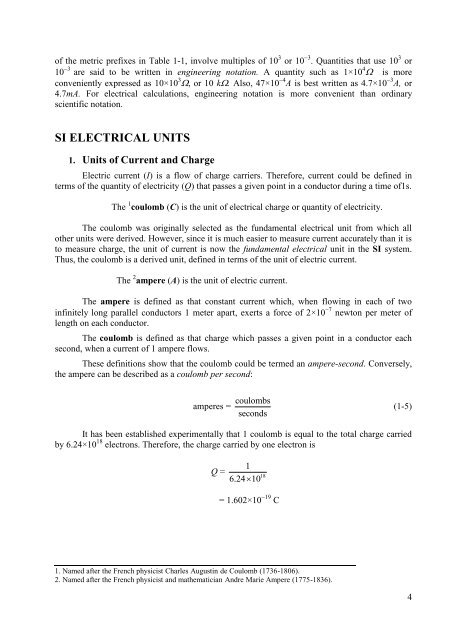Units, Dimensions, and Standards INTRODUCTION
Units, Dimensions, and Standards INTRODUCTION
Units, Dimensions, and Standards INTRODUCTION
Create successful ePaper yourself
Turn your PDF publications into a flip-book with our unique Google optimized e-Paper software.
of the metric prefixes in Table 1-1, involve multiples of 10 3 or 10 3 . Quantities that use 10 3 or10 3 are said to be written in engineering notation. A quantity such as 1×10 4 is moreconveniently expressed as 10×10 3 , or 10 k. Also, 47×10 4 A is best written as 4.7×10 3 A, or4.7mA. For electrical calculations, engineering notation is more convenient than ordinaryscientific notation.SI ELECTRICAL UNITS1. <strong>Units</strong> of Current <strong>and</strong> ChargeElectric current (I) is a flow of charge carriers. Therefore, current could be defined interms of the quantity of electricity (Q) that passes a given point in a conductor during a time of1s.The 1 coulomb (C) is the unit of electrical charge or quantity of electricity.The coulomb was originally selected as the fundamental electrical unit from which allother units were derived. However, since it is much easier to measure current accurately than it isto measure charge, the unit of current is now the fundamental electrical unit in the SI system.Thus, the coulomb is a derived unit, defined in terms of the unit of electric current.The 2 ampere (A) is the unit of electric current.The ampere is defined as that constant current which, when flowing in each of twoinfinitely long parallel conductors 1 meter apart, exerts a force of 2×10 7 newton per meter oflength on each conductor.The coulomb is defined as that charge which passes a given point in a conductor eachsecond, when a current of 1 ampere flows.These definitions show that the coulomb could be termed an ampere-second. Conversely,the ampere can be described as a coulomb per second:amperes = coulombsseconds(1-5)It has been established experimentally that 1 coulomb is equal to the total charge carriedby 6.24×10 18 electrons. Therefore, the charge carried by one electron is1Q =186.2410= 1.602×10 19 C1. Named after the French physicist Charles Augustin de Coulomb (1736-1806).2. Named after the French physicist <strong>and</strong> mathematician Andre Marie Ampere (1775-1836).4
















